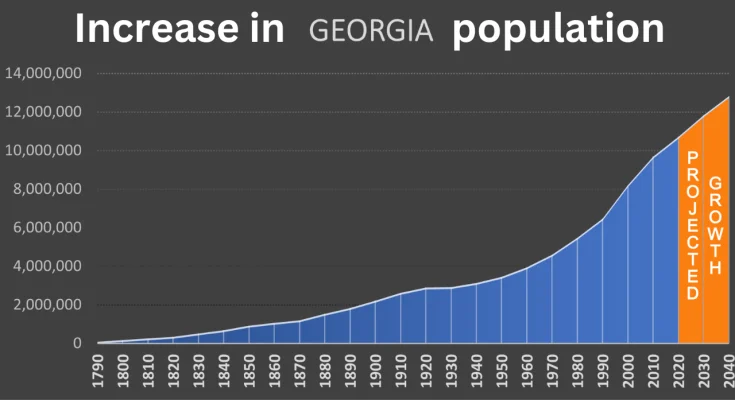Introduction to the population of Georgia Increase
Welcome to the bustling state of Georgia, where the population is on the rise! In 2023, population of Georgia experienced a significant increase in its population, growing by an impressive 1.1%. This exciting surge brings with it both opportunities and challenges for the state. So, let’s dig deeper and explore what factors contributed to this growth, how it compares to previous years, and what impact it has on Georgia’s economy and infrastructure after the increase in population of Georgia . Get ready for an insightful journey into the increasing population of Georgia!
Factors Contributing to the Increase
population of Georgia has been increased was experienced by Georgia , with a growth rate of 1.1% in 2023. Several factors have contributed to this upward trend.
Improved healthcare and medical advancements have played a significant role in the population increase. Accessible and high-quality healthcare services have led to reduced mortality rates and increased life expectancy. This has allowed for more individuals to live longer, resulting in an overall larger population.
Additionally, increase in the population of Georgia robust economy has attracted people from other states seeking better job opportunities and higher standards of living. The state’s diverse industries, including agriculture, manufacturing, technology, and logistics, provide ample employment options for both skilled professionals and blue-collar workers.
Furthermore, increase in the population of Georgia favorable business climate has encouraged companies to establish their headquarters or expand operations within the state. This influx of businesses creates job openings that attract individuals from across the country who are looking for career advancement or entrepreneurial opportunities.
Moreover, increase in the population of Georgia vibrant culture and rich history make it an attractive destination for retirees and those seeking a relaxed lifestyle. Its warm climate coupled with affordable housing options makes it an ideal place for individuals looking to retire comfortably without compromising on quality of life.
Lastly but not least important is the fact that Georgia is home to several esteemed educational institutions that draw students from around the nation. These students often choose to settle down permanently after completing their studies or contribute positively through research initiatives which helps drive innovation further increasing economic growth
In summary , various factors including improved healthcare facilities access along with strong economy offering better job prospects ,an appealing cultural environment ,a pleasant climatic conditions as well as reputable educational institutions are contributing greatly towards driving up the increase in the population of Georgia .

Read More Travelzens
Comparison to Previous Years
In the past year, increase in the population of Georgia . This growth is not an isolated phenomenon but part of a trend that has been observed over the years. When we compare the latest figures to previous years, it becomes clear just how significant this increase really is.
Looking back at the data from 2022, we can see that the population of Georgia grew by 1.1% in 2023. This may seem like a small percentage, but when considering the increase in size of population of Georgia , it translates into thousands of new residents calling this state their home.
To put things into perspective, let’s take a look at the numbers from five years ago. In 2018, Georgia’s population increased by only 0.7%. This means that in just five years, there has been a substantial jump in population growth.
The steady and consistent rise in population highlights several factors contributing to this trend. For one, Georgia offers attractive job opportunities across various sectors such as technology and healthcare. Moreover, its vibrant culture and affordable cost of living make it an appealing destination for individuals seeking better prospects or simply wanting to enjoy a high quality of life.
This comparison with previous years also sheds light on some challenges faced by the state regarding infrastructure and public services. With an increasing number of people moving here each year, there is added pressure on housing availability and transportation systems.
While these challenges are undoubtedly concerning for policymakers and city planners alike, initiatives have already been put in place to manage this growing population effectively. Investments are being made to enhance transportation infrastructure and expand housing options across different price ranges.
In conclusion (as specified), comparing Georgia’s current population increase with previous years showcases both progress and potential hurdles for this thriving state. Understanding these trends will be crucial for ensuring sustainable development while maintaining a high standard of living for all residents.
Impact increase in population of Georgia on Economy and Infrastructure
The population increase in Georgia has had a significant impact on the economy and infrastructure of the state. With more people calling Georgia home, there has been an increased demand for goods and services, leading to economic growth. This growth has resulted in job creation and opportunities for businesses to thrive.
In terms of infrastructure, the state has had to make adjustments to accommodate the growing population. There have been expansions to transportation networks, such as highways and public transportation systems, to handle increased traffic congestion. Additionally, there have been investments in education and healthcare facilities to meet the needs of a larger population.
The influx of new residents has also contributed to the housing market boom in increase of population of Georgia . As more people move into the state, there is a higher demand for housing, resulting in increased construction activity and real estate development. This not only stimulates economic growth but also provides more options for individuals looking for homes.
However, with these positive impacts come challenges as well. The strain on resources like water supply and energy can pose problems if not properly managed. It is crucial that policymakers work towards sustainable solutions that can support both current and future populations without compromising environmental integrity.
While the increase in population presents its own set of challenges, it also brings numerous benefits to Georgia’s economy and infrastructure. By effectively managing this growth through strategic planning and investment initiatives targeted at addressing key areas like transportation, housing, education,and sustainability,the state can continue to flourish economically while maintaining a high quality of life for its residents
Challenges Faced by the State
Challenges Faced by the State
As the population of Georgia continues to increase, it brings forth a set of unique challenges for the state to tackle. One of the key challenges is managing infrastructure and ensuring that it can support the growing population. With more people moving into Georgia, there is an increased demand for housing, transportation networks, and utilities.
The strain on existing resources poses a significant challenge for local authorities. They must find ways to expand and improve infrastructure without compromising quality or overburdening taxpayers. This requires careful planning, collaboration with different stakeholders, and innovative solutions.
Another challenge that arises from population growth is maintaining a high standard of education. As more families move into Georgia, there is a need for additional schools and teachers to accommodate the increasing number of students. Ensuring access to quality education becomes crucial in order to meet the needs of both current residents and newcomers alike.
In addition, healthcare services also face pressure as the population grows. Healthcare facilities may become overcrowded or understaffed due to increased demands for medical care. The state must take steps to ensure that healthcare providers are adequately equipped to handle this influx while maintaining high-quality standards.
Furthermore, managing natural resources becomes increasingly important in light of population growth. As more individuals settle in Georgia’s cities and rural areas, there may be higher demands on water supplies, energy sources, and agricultural land. Balancing these competing needs while preserving environmental sustainability presents yet another challenge.
Addressing these challenges requires proactive measures from local governments and policymakers in close collaboration with communities across Georgia.By identifying potential issues early on and implementing effective strategies, the state can navigate through these challenges and continue fostering sustainable growth
for its residents now and in years ahead.
Initiatives to Manage the Increasing Population
Initiatives to Manage the Increasing Population
As the population of Georgia continues to grow, it becomes imperative for the state to implement effective initiatives aimed at managing this increase. By proactively addressing the challenges that come with a growing population, Georgia can ensure sustainable development and improve the overall quality of life for its residents.
One key initiative is urban planning and infrastructure development. This involves carefully designing cities and towns to accommodate the needs of a larger population, such as expanding transportation networks, creating affordable housing options, and enhancing public amenities like parks and recreational facilities. By investing in these areas, Georgia can create livable communities that attract new residents while improving the well-being of existing ones.
Another important aspect is education and workforce development. With more people moving into Georgia, there is a greater demand for skilled workers across various industries. To meet this demand, the state must focus on providing quality education and training programs that equip individuals with relevant skills for employment opportunities. By investing in education from an early age through higher education institutions, Georgia can nurture a capable workforce ready to contribute to its growing economy.
Additionally, environmental sustainability should be prioritized as part of managing population growth. As more people inhabit an area, there is increased pressure on natural resources such as water supply and energy sources. Implementing eco-friendly practices like promoting renewable energy sources and encouraging conservation efforts can help mitigate these challenges while preserving Georgia’s unique natural environment.
Moreover, healthcare services need to be expanded to cater to a larger population effectively. This includes increasing access to primary care providers, ensuring adequate hospital facilities are available across different regions of the state, and promoting preventive health measures through awareness campaigns. By focusing on healthcare infrastructure improvements alongside population growth management strategies ensures that Georgians have access to essential medical services when needed.
Lastly but not least important are community engagement initiatives aimed at fostering social cohesion within diverse communities in Georgia. Encouraging dialogue between residents from different backgrounds promotes understanding while celebrating the unique cultural fabric of the state. This can be achieved through community events,
Conclusion
Conclusion
The population of Georgia has seen a steady increase of 1.1% in 2023, contributing to the state’s growth and development. This upward trend can be attributed to various factors such as natural growth, migration from other states, and an overall positive economic climate.
While this population increase brings numerous benefits to the state in terms of economic growth and cultural diversity, it also presents challenges that need to be addressed. The strain on infrastructure, healthcare services, and education systems requires proactive measures from policymakers and government officials.
To manage the increasing population effectively, Georgia has implemented several initiatives aimed at improving infrastructure capacity, expanding educational opportunities, enhancing healthcare services accessibility, and promoting sustainable development practices. By investing in these areas and planning for future growth responsibly, the state aims to ensure a high quality of life for its residents while maintaining its economic competitiveness.
As we move forward into the future, it is crucial for increase in the population of Georgia to continue monitoring population trends closely and adapt strategies accordingly. By addressing challenges head-on through strategic planning and collaboration between public entities and private organizations alike, it can successfully navigate the complexities associated with a population of Georgia .
Overall,the increasing population of Georgia serves as both an opportunity for progress as well as a call for careful management. With continued efforts focused on sustainable development and effective resource allocation,Gerogia stands poised to harness its demographic advantage for long-term success.
Read More interesting Article :This Is the Largest Military Base in Virginia




